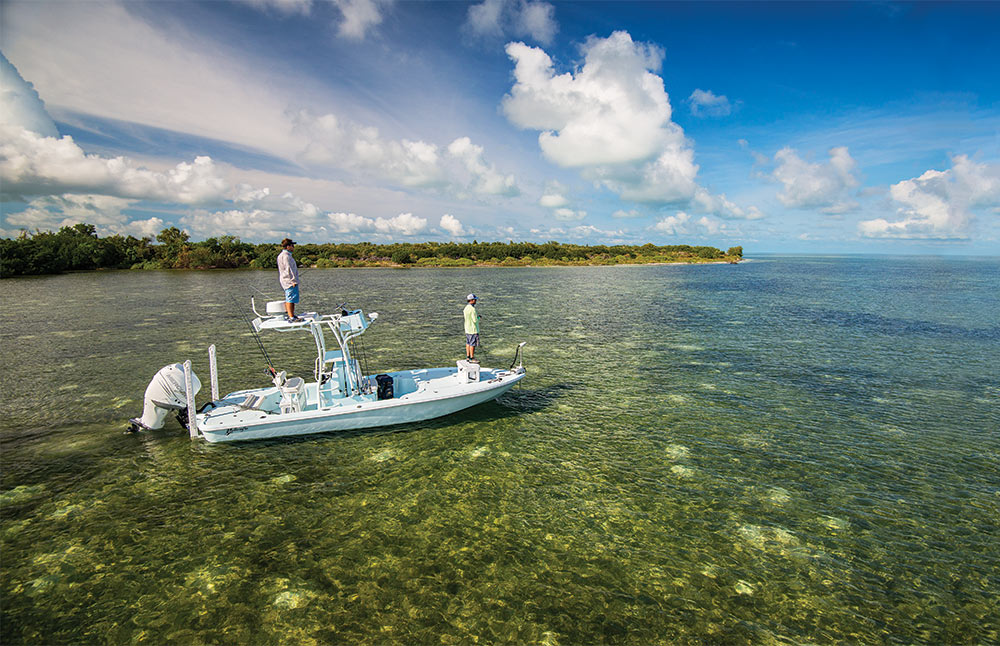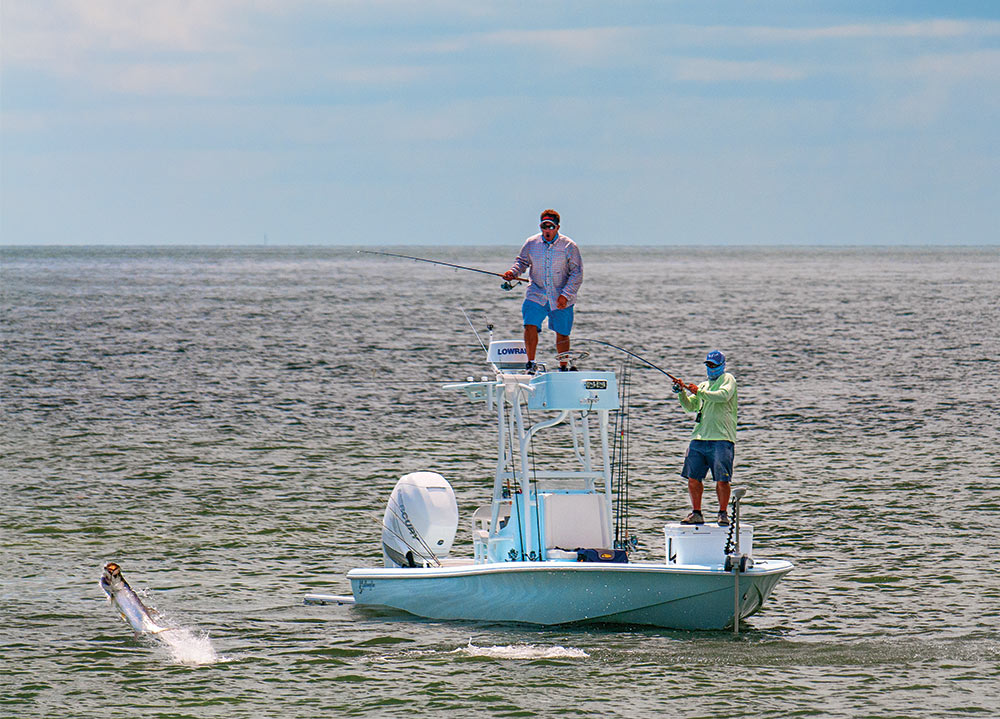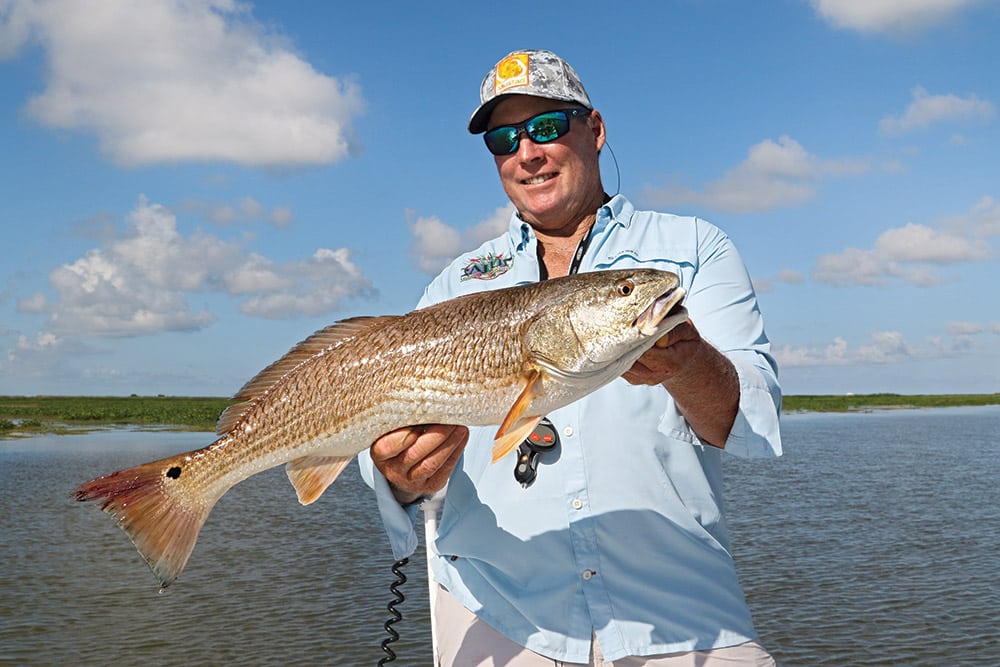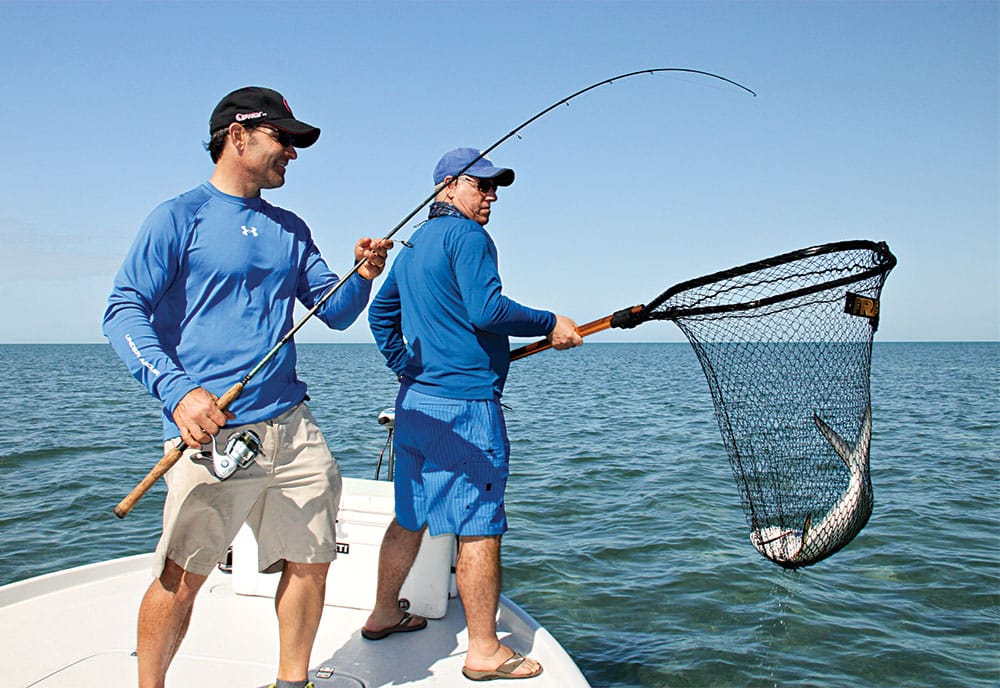
Ask a hardcore angler if he’d rather catch a dozen fish blind-casting or a couple sight-fishing and you’ll probably hear a consistent chorus singing the praises of that skill-meets-patience-meets-focus thrill fest we call sight-fishing.
Geographic distribution makes redfish the most commonly sight-fished species; however, bonefish, permit, snook, tarpon and sharks offer a similar cat-and-mouse challenge. Whatever your target, consistency demands a mastery of the three P’s: position, posture and presentation.
Notice that we did not include perfection. That’s because there’s no perfect formula for sight-fishing. Every scenario, every fish — often every hour — is different. Bracing your effort with awareness and adaptation yields consistency.
Worth noting: Bull redfish that no longer fear sharks, dolphins and ospreys usually require less finessing than slot-size reds. Also, fisheries throughout the Mississippi Delta, which have higher daily bag limits and less fishing pressure than, say, Tampa Bay, Florida, or Charleston, South Carolina, are inhabited by fewer educated and, therefore, skittish fish. Nevertheless, each fish yields to self-preservation, so mind these principles for maximum success.
Position
Keeping the sun at your back sounds good, right? Well, Capt. C.A. Richardson, who splits his time between Tampa Bay and the Mississippi Delta, says it’s hard enough hiding his 6-foot-5 frame from wary fish; he’s not about to give them such an advantage.
“I do not like to have the sun behind me because I become silhouetted, even though I’m in a low-profile technical skiff (an 18-foot Hell’s Bay Marquesa),” he says. “I usually like to have the sun at 45 to 60 degrees to one side. That way, I still see the fish, but I’m not completely silhouetted.”
Florida Keys guide Tom Rowland expects best visibility when the sun is at its highest, roughly 10 a.m. to 2 p.m. Maximum light penetration means maximum visibility, but there’s no overstating the importance of polarized sunglasses and a glare-blocking hat.
“The ideal scenario for my sight-fishing is clear water, wind blowing 10 to 15 from the east or southeast (ideal wind direction may vary by location), a high tide in the middle of the day, and a high-pressure area centered over the location, keeping the sky clear of clouds,” he says. “This allows me to go anywhere I want, fish an incoming and outgoing tide, and have no obstacles that might limit my ability to see fish in the water.
“When a cloud comes over, it is as if someone turned off the light switch. You can be looking at a fish headed directly to you and see it plain as day, but a cloud comes over and you lose it completely.”

Inferior conditions make subtle cues golden: wakes, boils, dust-offs, tarpon rolling or gulping air, the white flash of permit lips. To that latter point, Capt. Ryan Lambert of Buras, Louisiana, likens sight-fishing to hunting: Often, you won’t see your quarry until you spot an ear or a tail, or a fin or a belly flash.
On partly cloudy days, Richardson targets specific zones devoid of cloud glimmer, which obscures fish and relevant bottom features. Focusing on areas of highest visibility maximizes time management.
Buttressing all of these points stands one foundational postulate: Distance is your friend, so stay as far back as your vision and casting range allow. Long rods and braided line help. If casts fall short, you can always inch forward. But push too close and backing off won’t help.
Fishing Posture
Capt. Jamie Hough, who sight-fishes reds in coastal South Carolina as well as his northern Gulf tournament grounds, knows the importance of reading fish. Hough offers a rundown that, while based on redfish, generally applies to bonefish or any others you’re looking at.
• Cruising: As they mosey along with pectoral fins tucked tight, these fish aren’t burning many calories, so they’re not likely to eat. Such disinterest is common during slow current. Similarly, Richardson knows that reds snuggled close to the bottom — either basking in warm mud or napping away a slack tide — aren’t worth any effort.
• Tipping: Just the upper edge of the tail breaks the surface, often appearing to make a figure eight as the fish grazes. These fish are actively looking for food in a particular area, so a well-placed bait stands a good chance of connecting.
• Tailing: Head down, tail up, the fish holds at about a 45-degree angle for specific bottom feeding. Maybe it’s rooting a meal out of the seagrass or sucking a fiddler crab out of its hole. Definitely a high-value target, but be patient and let the fish complete its immediate task. A tailer has a very narrow field of vision, so don’t waste a lot of effort positioning your bait, unless the fish has buddies nearby.

• Rolling: Belly flashes indicate a happy, relaxed school that’s likely looking to chow. The bigger the school, the higher the feeding competition. But more bodies mean more chances of spooking one. Safety in numbers means if your buddy bolts, you follow — no questions asked.
Presentation of Bait
Most agree that elevation — a casting tower, poling platform, or cooler — offers undeniable benefits. Wherever you stand, consider that most fish feed into the current, so make sure you’re uptide of their position. Specific post-cast movements vary by species, but Richardson offers this suggestion for what he calls a smart cast.
“Choose a landing area far enough away from the fish to prevent spooking them, but at an angle that allows you to bring the lure to them and make it look natural by the time it gets to the fish,” he says. “Unless you’re fly-fishing, if you land that lure anywhere near the fish, they’ll spook.
“Sometimes 10 feet away is too close. You may need to drop the lure 20 to 30 feet away and then give it enough time to acquire a normal motion as it moves by the fish.”
Passing angles, Richardson says, matter a lot. A bait should appear in front of the fish where their binocular vision provides a clear, nonthreatening image. Baits that approach from one side may appear unnatural and send the fish packing.
It’s a precision born of repetition to which Rowland has committed countless hours of casting at a particular blade of grass or specific bubbles on the surface. Forget that horseshoes and hand grenades nonsense; close enough won’t fit this dead-on scenario.
“I’ve seen instances where if you put your bait 6 inches to either side of a fish, it won’t eat, but if all it has to do is open its mouth, it’ll eat,” Hough says. “These fish live in a cost-benefit world; they measure everything by whether the effort is going to cost more calories than they’ll gain by eating a bait. So you have to present that bait so that it costs the fish the fewest calories to catch it.”
Relevant points, for sure, but even a properly distanced cast can nullify your presentation attempt with an awkwardly intrusive plop. Justify all that diligent searching and a stealthy approach by delivering your bait with the quiet precision of a scalpel, not the explosion of a baseball bat. Feather your spool at the end of a cast to smoothly stop the bait and make it enter the water like an arrow.

The totality of sight-fishing defies simple summation, but Rowland comes close with a parting shot that paints a moment-of-truth image we’ve all loved and lamented: “A good cast is a beautiful thing; a bad one can be soul-crushing.”
Control What You Can
The fish seldom make this game easy, so spare no effort to create a quiet and efficient approach.
• Stop and Go: Capt. C.A. Richardson relies heavily on his Power-Pole for capitalizing on sudden opportunities and for the incremental advancements needed to work an area. Using the C-Monster Control System, he sets his deployment speed to low and the bottom sensitivity to light. This ensures a smooth, subtle stakeout, and Richardson also presets the height so the stake is 6 to 8 inches off the bottom. “When I push-pole into position and stop, I don’t have to wait for full deployment, and it makes a lot less noise,” he says. “It’s just two taps and it’s down, and I typically stop in less than a boat length.”
• Entanglements: Capt. Jamie Hough lays a damp towel over his trolling motor to cover the many fly-line-grabbing pieces.
• On the Ready: When poling for others or solo, keep a rod on the platform deck, under your belt, in your back pocket, or tucked into your waistband. Capt. Tom Rowland often keeps two handy, one with a crab for permit and one with a shrimp for bonefish.
• Glacial Pace: Richardson says the biggest mistake people make in sight-fishing is moving too fast. You have to slowly encroach on the fish without them feeling the pressure wake from your boat. When you’re moving too quickly, you’re scaring fish before you ever get to them. “The stingrays, the mullet, they’re getting nervous around you and telegraphing your presence. The fish you spook are going to run into other fish and spook them too. One of those fish is going to run past the one you’re targeting, and it’s going to drop its tail and move off.”
• Silence Is Golden: Most know the rule about no stomping, slamming lids, slushing cooler ice or dropping jig heads, but also consider the inadvertent operational sounds such as snapping a bail shut, closing a tackle box latch or laying a Push-Pole on the deck. With bails, latches and the like, control the movement through its completion to minimize the sonic crescendo. And laying a beach towel on the stern provides a soft, noise-dampening contact point for resting the Push-Pole. Remember, your opportunities will often number fewer than those of blind-casting, so make the most of every shot your sight-fishing efforts afford.









